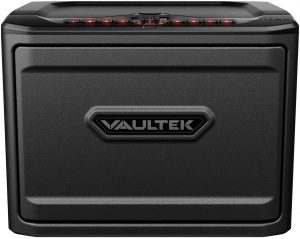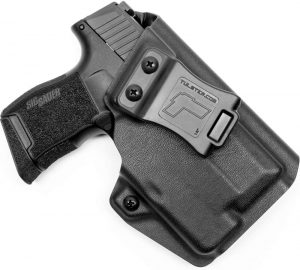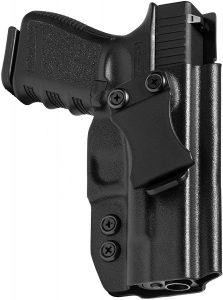With the COVID-19 pandemic ravaging the world many people have purchased a firearm in order to protect themselves and their families. If that’s you and you’ve never owned a firearm before there are a few things that you must know in order to be able to handle your new weapon correctly and safely.

Know The Universal Firearm Safety Rules
Congratulations, you’re a gun owner. You now have the ability to protect yourself and your family, as well as the responsibility to handle, use and store your new weapon responsibly. The first step to do that is to know and follow the Universal Firearm Safety Rules. They consist of 4 rules which are as follows;
1) Treat All Guns as if they are Loaded
Accidental or negligent discharge of a firearm that the owner thought was unloaded is one of the leading causes of firearm deaths. To avoid this tragedy, always assume a gun is loaded when you first pick it up. Some say that, even if you know it’s unloaded, pretend the gun is loaded and handle it as such.
I have heard many sad stories of people accidentally shooting others or property by neglecting this rule. One person I know was shot by a 357 Magnum point blank by a “friend” thinking the gun was unloaded, and another person I know shot their $3,000 stereo system thinking they were dry firing it.
2) Keep Your Finger Off of the Trigger Until you are Ready to Shoot
Putting your finger on the trigger before you’re ready to shoot is incredibly risky. Instead, put your trigger finger straight out and over the trigger guard until you need to take a shot. This is called trigger discipline.

You must always practice this until it becomes second nature, it might take time but is the safest way to handle a gun. It is also a quick way to tell if someone is experienced with firearms or not.
3) Never Point a Gun at Anything You Don’t Intend To Shoot and Destroy
This includes your own body, anyone around you, pets, etc. Unless you plan to shoot and kill it, do not point your gun at it, ever. Again, get this rule burned into your noggin.
4) Know What Is Around Your Target
This includes to the left, the right, in front of and behind your target. If there is, for example, a backstop behind your target and you don’t know what’s behind that backstop you could accidentally shoot someone who’s there but you can’t see.
Storing Your Gun Safely
Safe gun storage depends on several factors, including who lives in your home and who has the ability to get to your gun. If you have children in your home, putting your gun in a secure location is a must. It is very irresponsible leaving your firearm in a location where your children could access and harm themselves or others. This unfortunately happens way more than it should.
Biometric safes, also known as finger print safes, are a great solution for those wanting quick access to their firearm while keeping them out of the hands of children.
For handguns please consider something like a Vaultek above, and for long guns consider getting a large secure safe with quick access panel like the Steelwater below.
The truth is, in the case of an armed intruder you need to be able to quickly access your gun and use it while keeping your most vulnerable family members safe from themselves.
Aircraft Loading
This is a slight alternative for when you keep a loaded gun at home and at-the-ready. It involves not putting a round in the chamber but having a full magazine in the gun. That way, if you need to use it quickly, all you need to do is rack the slide and your gun will be ready. A small child would most likely not be able to rack the slide, making it a safer choice.
Learn To Safely Operate a Gun
Handling a gun means knowing how it works, its parts and how to either load and/or unload your weapon. The best way to do this is learn with an experienced shooter but here is a quick run down.
Loading your Gun
For specific details loading your firearm, please refer to manufacturer instructions. For a quick example, lets assume you purchased a semiautomatic handgun like a Glock or similar:
Step 1- Pick up your gun with your trigger finger to the side following Universal Rule #2
Step 2- Insert a loaded magazine firmly until it is completely seated in the firearm
Step 3- Grab the slide and pull it back with a hard, quick motion (called ‘racking it’), letting your hand slip off the back so that the slide springs back into place. Allow the slide quickly release, do not “ride the slide”, just let it fall. Otherwise the round may not fully chamber.
A round should now be chambered in your gun and it is ready to fire.
Unloading your Gun / Clearing Your Gun Out
Step 1- Push the magazine release button on the side of the gun with your thumb to release the magazine into your free hand. Remember, there is still a round in the chamber.
Step 2- Grab the slide and rack it back hard, letting your hand slip off the back. The round should fall out of the chamber.
Step 3- Double Check that there’s no round by racking the slide a 2nd time
Step 4- Visually Check the Chamber. To do this, use the slide release button (which is on the same side as the magazine release button). Pull the slide back while pulling the slide stop button down. Then, let the slide stop button go and release the slide. It should stay in place and open so that you can look inside the chamber.
Step 5- Check the chamber with your finger to make sure it is empty.
Step 6- Look away and then back to your gun a 2nd time to check the chamber again and make 100% certain it is empty.
Important Note #1
When you are unloading/clearing out your gun, do not do anything else. Don’t talk to anyone, don’t watch TV, ensure the area is safe and follow all universal safety rules.
Important Note #2
Follow the exact same routine every time you clear your gun. This will substantially lower the risk of leaving a round in the chamber.
Carrying Your Gun Safely
Your Gun and Holster
If you are in a location where you can carry, you will want a good holster. You should think of your gun and holster like a happily married couple; made for each other so that they fit perfectly. What you want is a holster that fits your gun perfectly, is tight and allows you to unholster your weapon quickly and easily. A loose-fitting or general-purpose holster is not recommended, especially if you’re going to be carrying it with you all the time.
Your Holster Should;
- Be a snug fit for your gun
- Have good trigger guard support
- Have good tension but not be too tight
- Fit your lifestyle
- Fit your wardrobe
Holster Types
- Appendix Holsters sit in the front of your pants
- Side Holsters can sit at 3:00 or 4:00 to your side
- An Ankle Holster is strapped to your ankle
Kydex holsters a great choice and are extremly popular, find a model that fits your model of firearm. Check out these Kydex holsters on Amazon.
The fact is, a gunfight happens extremely quickly. You need to be able to access your gun just as quickly but, when it’s holstered, be sure that it’s safe.
Gun Training
This might be the most important part of the guide. Here’s a fact; shooting a gun accurately is not easy. The first time at the shooting range, you may think you have an inaccurate gun with all your missed shots. Nope. You are just a horrible shot. It takes skill, which means it also takes a lot of practice. If you really want to learn how to use a gun and become good at using it, you should get training from a local gun expert and practice often.

Keep in mind that criminals are ambush hunters, which means they hunt by ambushing their prey (you). In a gunfight, there will be a lot going on. It will happen quickly, it might be dark, you might be using your free hand to fight and you will almost always be under a great deal of stress. Shooting well and accurately under these conditions is not easy even if you do have experience and have gotten training. If you haven’t, the results might be fatal (and not to the criminal)
It’s Not the Arrow, It’s the Indian
This old saying goes to the heart of why you need training. Anyone can fire a gun but most can not do it well. But, if you are trained and have many hours of practice, you can shoot any gun well and accurately. Another way to say it would be this; it’s not the gun, it’s the shooter.
Having a Gun Des Not Make You Safe
One piece of information you need to know is simply that having a gun doesn’t make you safe, knowing how to use a gun well and having quick, reliable access to that gun makes you safe.
Now that you own a gun, be safe by learning how to handle it and shoot it as well as you possibly can.
We hope this guide answered your questions and gave you the information you were seeking. Best of luck with your new gun. We hope you never need to use it in defense of yourself or your loved ones but, if you do, we hope that the information we’ve given allows you to do that. Be well and be safe.
Caligunner Copyright © 2020.
All Rights Reserved. Caligunner.com is a participant in the Amazon Services LLC Associates Program, an affiliate advertising program designed to provide a means for sites to earn advertising fees by advertising and linking to amazon.com.





